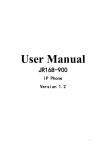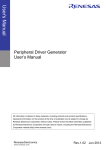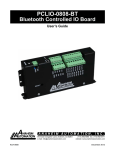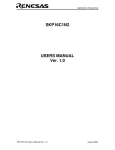Download Below is the Frequently Asked Questions List for IO Wizard
Transcript
Below is the Frequently Asked Questions List for IO Wizard FAQ 001 [30.11.2006] Function: Part number / Pin Package Question: For M16C/Tiny series, I could not find my target MCU part number in the MCU list? Answer: On IO Wizard, the peripheral settings display for each MCU group are designed based on higher pin package device. Corresponding to the peripheral settings supported on IO Wizard, only higher pin package MCU devices are listed for user selection. For M16C/tiny series: (i) M16C/26A group – 48-pin package device part number is listed for selection. 42-pin package device part number are not available for selection. (ii) M16C/28 and 29 group – 80 pin package device part number are listed for selection. 64-pin package device part number are not available for selection. FAQ 002 [30.11.2006] Function: Timer operation with external clock Question: For timer peripheral settings, the IO Wizard did not support timer calculation when external clock is selected as count source frequency for timer mode operation. Why? Answer: In order to run the timer calculation, a known timer count source frequency value is required. Calculation cannot be carried out for external clock because it is an unknown frequency to IO Wizard engine. FAQ 003 [30.11.2006] Function: UART asynchronous serial I/O mode with external clock Question: For UART asynchronous serial I/O mode, the IO Wizard did not allow me to select external clock for baud rate generator. Why? Answer: IO Wizard does not allow external clock source selection for UART asynchronous serial I/O mode due to following reason. For UART, IO Wizard would like to illustrate the correct setting of bit rate register as according to baud rate. In order to run the baud rate calculation, a known count source frequency value is required. Calculation cannot be carried out for external clock because it is an unknown frequency to IO Wizard engine. FAQ 004 [30.11.2006] Function: Entering wait mode or stop mode (for low power consumption) 1/7 Question: On IO Wizard, there isn’t any available setting for entering to wait mode or stop mode. Why? Answer: The output files of IO Wizard are meant for illustration of source code program sample and also the peripheral initialization setting. In MCU application, entering to wait mode or stop mode won’t be done at beginning of program. Therefore, IO Wizard does not support setting for wait mode or stop mode. Scenario for wait mode and stop mode: Upon MCU reset, the program will do necessary system/machine initialization and set-up, after the program has carried out some process and came to a state whereby MCU is idling, then it is times to save power consumption by entering into wait mode or stop mode. FAQ 005 [30.11.2006] Function: Watchdog timer Question: On IO Wizard, there isn’t any available setting for watchdog timer setting. Why? Answer: Watchdog timer setting is not supported on IO Wizard due to following 2 reasons. (i) Watchdog timer is a function to detect when the program is out of control. Watchdog should be included into the software at very last stage of software development that is after the system software is done and tested. (ii) Major IO Wizard users are inexperienced in MCU software writing. These users will have hard timer to debug the software if they turn on the watchdog and do not use it properly. [Remark: The correct way to use watchdog timer is: After the watchdog timer is started, the program should include “reset watchdog timer counter’ setting at different points of the program code so that watchdog timer counter can be regularly get reset during actual program execution.] FAQ 006 [30.11.2006] Function: Voltage detection circuit Question: I could not find voltage detection setting on IO Wizard although the MCU data sheets stated it is available for my target MCU. Answer: Present IO Wizard does not support voltage detection circuit setting. FAQ 007 [30.11.2006] Function: Oscillation stop detection function Question: I could not find oscillation stop detection function on IO Wizard although the MCU data sheets stated it is available for my target MCU. 2/7 Answer: Present IO Wizard does not support oscillation stop detection function. FAQ 008 [30.11.2006] Function: CRC cyclic redundancy code Question: I could not find CRC (cyclic redundancy code) setting on IO Wizard although the MCU data sheets stated it is available for my target MCU. Answer: Present IO Wizard does not support CRC function. FAQ 009 [30.11.2006] Function: Port register setting Question: After I have set the port direction to output, I would like to do port level setting. But I could not find available setting on IO Wizard. Answer: IO Wizard only support port direction selection for initialization setting. After the output source files are generated, user can manually add in the port level setting line in the main function or after port direction setting line in init function. FAQ 0010 [30.11.2006] Function: Port direction for external interrupt pins, timer pins, serial and other communication protocol pins, ADC pins Question: Does IO Wizard auto set the port direction of external interrupt pins, timer pins, serial and other communication protocol pins, ADC pins as according to peripheral operation mode? Answer: No. IO Wizard does not do consistency check for user’s port direction setting with peripheral operation mode setting. In another words, IO Wizard will not auto change the port direction. User is advised to read and follow the advice comment stated in the config.c file, under the title area of each peripheral settings. FAQ 011 [30.11.2006] Function: Program lines Question: Will those program lines displayed in Status window during peripheral settings, be generated into the output .c file? Answer: Yes, all program lines displayed in Status window will be generated on the output, c file. However, the order of program lines shown in status window and program lines generated in the output .c file might not be the same. 3/7 FAQ 012 [30.11.2006] Function: M16C/26A, M16C/28, M16C/29 - Incorrect operation on timers or serial I/O for f1 and f2 clock select. Question: When I tested the timers or serial I/O on actual system, the operation is incorrect. The problems happened only for f1 and f2 clock select. Target MCU: M16C/26A, M16C/28, M16C/29. Answer: For M16C/tiny series MCU, a single PCLK0 bit is used to select f1 or f2 clock for few peripherals (Example: M16C/26A, PCLK0 control clock select for timers A, B and dead timer as a whole. M16C/28 and M16C/29, PCLK0 control clock select for timer A, B, S, dead timer, S I/O 3, S I/O 4 and multi-master I2C bus as a whole). Also, PCLK1 bit is used to select f1 or f2 clock for UART0 to UART2 as a whole. The IO Wizard engine does not do consistency check on f1 and f2 clock select for inter-related peripherals with respect to PCLK0 bit and PCLK1 bit. Scenario: On IO Wizard, user can select f1 for timer 1, f2 for timer 2. In this case, there is conflict on PCLK0 setting. User is advised to read and follow the advice comment stated in the config.c file, under the title area of each peripheral setting. Take into the consideration of whole system operation, user should decide choice of f1 or f2 and manually set PCLK0 and PCLK1 bit by themselves. FAQ 013 [30.11.2006] Function: Version number Question: How to check the version number of IO Wizard software? Answer: On IO Wizard main window (system setting window), do a right click on “IO Wizard” title”, and then select “About IO Wizard…” to view IO Wizard version number. FAQ 014 [30.11.2006] Function: PLL clock Question: For M16C/tiny series MCU, why the peripheral frequency value used doesn’t tally with my clock frequency and PLL multiplication factor selection? Example: For M16C/26A, I selected 16MHz clock and PLL multiplying factor of 2 in main window, but the frequency displayed on bottom bar of peripheral window is 20MHz. Answer: When PLL is used, according to combination of user selection clock frequency and PLL multiplying factor, there is possibility that the calculated frequency falls to invalid range. When such situation happen, IO Wizard will automatically set to use the maximum PLL clock frequency. Refer to above example: For M16C/26A, PLL clock frequency spec is 10MHz to 20MHz. When calculated frequency is (16MHz x 2) which is 32MHz (invalid), IO Wizard will automatically set to use 20MHz. 4/7 FAQ 015 [05.03.2007] Function: Part number Question: For R8C/22, 23 group devices, I could not find my target MCU part number in the MCU list? Answer: For R8C/22, 23 groups, the MCU settings on IO Wizard are designed based on J version devices. Therefore, only J version device part number are listed for selection. FAQ 016 [07.03.2007] Function: UART asynchronous serial I/O mode (transmitter and receiver) Question: For UART asynchronous serial I/O mode, how to set both receiver and transmitter to same UART channel? Answer: On IO Wizard, user can only select either transmitter or receiver for UART operation. In this way, inexperience MCU user can have clearer information on the related settings for transmitter itself and just receiver itself. If you want to have both receiver and transmitter for same UART channel, you can manually integrate the program lines for UART transmitter and UART receiver into the same file. FAQ 018 [07.03.2007] Function: Type Code / Product Number for H8/SLP series Question: For H8/SLP series, I could not find my target MCU type code in the MCU list? Answer: On IO Wizard, the peripheral settings display for H8/38347 group is designed based on product number. Corresponding to the peripheral settings supported on IO Wizard, only product number for MCU devices is listed for user selection. For H8/SLP series: (i) H8/38347 group – Available product numbers are H8/38342, H8/38343, H8/38344, H8/38345, H8/38346 and H8/38347. (ii) H8/38347 group - Each product number has options for Mask ROM versions, F-ZTAT versions, Type Code, Mark Code and Package (Package Code). FAQ 017 [07.03.2008] Function: Invoke HEW from IO Wizard Question: Why is it that I cannot export the generated source codes into HEW? 5/7 Answer: The prerequisite for the exporting to work is that HEW and HEW Target Server (COM) has already been installed on your machine. If HEW is already installed on your machine, please verify it is version 4.2 or above. FAQ 018 [07.03.2008] Function: Invoke HEW from IO Wizard Question: Why is it that I cannot export the generated source codes into HEW even when HEW is opened? Answer: You might have open HEW without opening any workspace. Please open an existing workspace and try again. FAQ 019 [07.03.2008] Function: Invoke HEW from IO Wizard Question: How to register HEW target server? Answer: 3 setup steps must be done before we can invoke HEW from IO Wizard. 1. Check that Hew 4.02.00 and above has been installed 2. Registering HewTargetServer.exe in your Registry. In windows explorer, navigate to the latest copy of Hew and double click on REGISTERSERVER.bat. (e.g. C:\Program Files\Renesas\HEW\ ) 3. Registering EcxHewTargetServer.dll. Launch HEW and in the Welcome dialog box, click on the [Administration…] button. Under the Extension components folder, you will see that EcxHewTargetServer.dll is not registered. Next, click the [Search disk…] button and choose [Start]. Select HewTargetServer from the components listed and click the [Register] button. After setup has been done, launch IO Wizard and try to invoke HEW again. FAQ 020 [01.04.2008] Function: Invoke HEW from IO Wizard Question: Can IO Wizard insert source codes into multiple HEW workspaces at one go? Answer: IO Wizard is designed to insert source code into the current active HEW workspace. As such, please ensure that only 1 copy of HEW is opened when IO Wizard is to be used. 6/7 FAQ 021 [02.04.2008] Function: Invoke HEW from IO Wizard Question :I have followed the instructions in the User Manual regarding the setup for invoking HEW from IO Wizard. However, I am still getting error message. Answer: IO Wizard needs to be closed and reopened if you have made any changes to the environment settings. If you are using this new function for the first time, restarting IO Wizard will solve the problem. 7/7






















